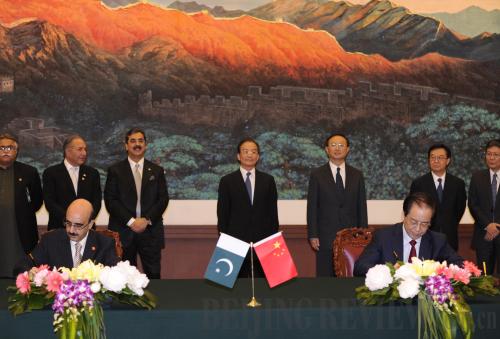|
 |
|
LOOKING AHEAD: Pakistani Prime Minister Syed Yousuf Raza Gilani attends an agreement signing ceremony in Beijing on May 18, along with Chinese Premier Wen Jiabao. Gilani paid an official visit to China on May 17-20, as part of the two countries' celebrations of the 60th anniversary of their diplomatic relations (CNSPHOTO) |

Rich imagery is important in describing Pakistan-China relations. Last year, on the morning of December 19, addressing a packed session of Pakistani parliament, Premier Wen Jiabao said that friendship between our two countries is a "lush tree with deep roots and thick foliage, full of vigor and vitality." The sentimental bond between our peoples is thus a constant image. An aura of warmth and affection permeates our relations. Diplomats in Beijing and around the world hear the poetic expressions suggesting that Pakistan-China friendship is all-weather and time-tested; that this relationship is taller than the Himalayas and deeper than oceans; and that it is stronger than steel, and sweeter than honey. Some do offer envious compliments and ask about the secret of the longevity and depth of this relationship.
Well, let us try to figure out the secret of this unique bond.
The first crucible of our friendship has been history. Scholars and students are familiar with recent the history of Pakistan-China relations. But our relations go far back. It is obvious that the territories of Pakistan and China are joined by mountains and rivers or the so-called geographical fault lines. Pakistan and China also share civilizational fault lines. Monks and envoys traversed the daunting heights of the Karakorum, the Hindukush and the Himalayas to connect the Gandhara and the Indus Valley civilizations with the Chinese civilization. Fa Xian and Xuan Zang, in the 4th and 7th centuries, respectively, were not deterred by the inaccessible altitudes of these mountain ranges. Many scholars from the territory that is now Pakistan traveled to China to understand and imbibe the glorious civilization of China. So, cross-fertilization of our civilizations took place much before the modern era.
The founding of the People's Republic of China in 1949 was a truly historic event. And so was the independence of Pakistan in 1947. Pakistan recognized China on January 4, 1950, and established diplomatic relations on May 21, 1951, following negotiations with Pakistan's first Charge d' Affaires who had arrived in Beijing in April 1951. The first Chinese Ambassador to Pakistan went to Karachi in September 1951 and Pakistan's first Ambassador to China arrived in Beijing on November 1, 1951.
These are the beginnings that we shall celebrate this year after six decades. The year 2011 has been designated the "Year of China-Pakistan Friendship." We have decided to hold a series of activities in the political, economic, trade, military, cultural, sporting and education fields to commemorate the strength of our bilateral relations and to show the resolve to take it to new heights.
We can identify three periods in our relations. Because of the Cold War, the 1950s was a period of uncertainty in Pakistan-China relations, though efforts started right in the beginning for engagement. During the Bandung Conference in 1955, Premier Zhou Enlai and Prime Minister Mohammad Ali Bogra agreed to strengthen exchanges and cooperation between the two countries. On May 23, 1955, Chairman Mao Zedong, while talking to our Ambassador in Beijing Sultanuddin Ahmed, expressed the hope that, given goodwill between the two countries, relations would grow stronger and friendlier.
In the late 1950s and early 1960s, the leadership of the two countries steered Pakistan-China relations toward closer understanding and solidarity. Pakistan advocated China's entry into the United Nations in 1961. In 1963, China and Pakistan signed a boundary agreement. This was a very significant milestone as it underlined and displayed the emerging trust between the two neighbors. The agreement was signed in February 1963 in Beijing by Pakistan's Foreign Minister Zulfiqar Ali Bhutto. This also showed Pakistan's independence in its foreign policy and its growing faith in Sino-Pakistan friendship.
From this point onward, the third phase of relations between our two nations began which was characterized by mutual confidence, deep trust, and growing cooperation. This period can be called a period of consolidation and expansion and it has continued up to this point.
|
